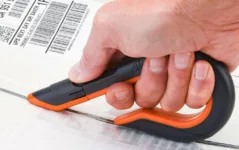Ever since primitive humans began chipping at flint and obsidian to make a cutting edge, knives have been part of us. Cutting tools are as quintessentially human as pounders and diggers – hammers and spades in modern parlance.
Knives took quantum jumps forward with the smelting of copper and then later with tempering iron into steel. And that’s where they stayed – until today.
Ceramics – not just for crack pots
When we hear the word “ceramic,” pictures of flower pots and art projects come to mind. From the Greek word keramos, which means “pottery,” ceramic refers to anything made from clay which is baked for hardness – ceramic tile, for instance.
Ceramic pottery has been around since long before the invention of writing. It’s ability to withstand high temperatures made metallurgy possible, ushering in the Bronze Age and eventually the Iron Age. Out of this technology also came porcelain and glass, both of which offer an attractive, shiny surface to artisans and fans of pretty things.
The Industrial Age found many more uses for ceramics. They make excellent insulators for electric wires, for example. Today, ceramics are making appearances in unexpected places.
Stealing from steel
Steel has been, for lack of a better metallic word, the gold standard for blades for over a thousand years. It’s tough and can be sharpened to surgical efficiency. But steel has a few drawbacks. It cannot be shaped in the way clay can. Three-D printers won’t be able to spit out complex steel machinery, so ceramics offer possibilities in this industry that steel doesn’t. Virtually any device that can be made from metal can now be made from clay, including the box it comes in and the box cutter.
Ceramics are also harder than steel. Almost as hard as diamonds, in fact. This characteristic makes them able to hold an edge longer than steel blades can. Unfortunately, ceramic blades can’t be sharpened by the same tools that sharpen steel. They’re either not hard enough to sharpen ceramic blades or they chip them. To replace kitchen knives, ceramic blades have to come with a set of diamond dust sharpeners or specially made electric sharpeners.
Ceramic blades don’t rust or stain. They won’t be eaten away by acids in the food. They’re easy to use, lightweight, and don’t carry odors. They can be as easy to clean as Teflon but without the concern for carcinogens released into the food with heat. (Teflon doesn’t really do that, but a lot of people think it does because a known carcinogen is used to make it.)
Variety – the spice of knife
Ceramic blades are particularly useful for thin slicing foods. (Indeed, they are the preferred blade for microtomes, the blades used to slice meticulously thin and even sections for microscope slides.) Because the actual chemistry of ceramic blades can be modified to suit the task, knives can be created to specialize in slicing carrots or just peeling them, chopping hard substances like dried cloves or T-bones, or cleanly cutting sticky cheeses or soft breads. Many manufacturers carry patents on their ceramic compositions.
Ceramic blades are commonly white, but they can be made in a variety of colors, an option that enhances marketability. They can be decorated in ways steel knives can’t.
The biggest disadvantage of ceramics over steel is that they are brittle. They are more likely to break if you drop them on a hard surface or use them to pry things. It all comes down to weighing the advantages of one material over the other.








